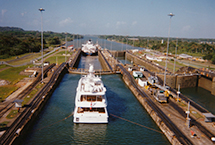 |
 |
|
| eNews • April 2015 | ||
| Promoting a Cost-Effective, Reliable and Competitive Transportation System |
||
 Panama discusses new locks for 20,000-TEU ships
Panama discusses new locks for 20,000-TEU ships
A year before its scheduled completion of a $5 billion-plus expansion, the Panama Canal Authority is discussing the idea of building even larger locks to allow head-to-head competition with the Suez Canal.
Workers are installing 22-story lock gates on new locks that are scheduled to begin operation April 1, 2016, and handle container ships with capacities of up to 14,000 twenty-foot-equivalent units.
While that work continues, the canal authority is looking ahead to a fourth set of locks that would accommodate ships as large as 20,000 TEUs, Jorge Quijano, the canal authority’s chief executive, told the Reuters news agency.
If the canal goes ahead with the project, Quijano said it could be completed within 15 years. He said financing options include issuing bonds and using canal revenues.
The larger locks would make the Panama Canal accessible to the largest container ships currently afloat. Those ships now can transit the sea-level Suez Canal but are too large for Panama’s locks.
"Looking at our geology and the experience we gained with this current expansion, we estimate it's a project that could cost between $16 billion and $17 billion," Quijano said.
Quijano told the JOC’s TPM Conference in Long Beach, Cal. on March 3 that the canal agency had already chosen the route for a fourth set of locks parallel to the third set that are still under construction and scheduled for opening to commercial traffic in the first quarter of 2016.
China Harbour Engineering Company Ltd (CHEC), a subsidiary of state-owned China Communications Construction Co Ltd, has voiced interest in building and financing a fourth set of locks in Panama, and Quijano said company officials met with him this week.
In Nicaragua, a Chinese businessman has proposed building a $50 billion canal across the country to rival Panama's, but that project faces steep financial, feasibility and environmental challenges.
When Panama’s current expansion was planned two decades ago, few anticipated the rapid growth in container ship sizes. Ships as large as 19,000 TEUs already are in use, and MOL this month announcedcontracts for six 20,150-TEU vessels.
Existing locks on the century-old canal restrict Panamax ships to the 4,500-5,000-TEU range.
Quijano said container ship traffic through the canal has risen around 3 to 4 percent in the last few months because of congestion at U.S. West Coast ports. "It has had a positive impact for us, but the Suez Canal has been the big winner because they can handle the post-Panamax ships," he said.
The current Panama Canal expansion was originally budgeted at $5.25 billion, but costs have risen amid a dispute with Grupo Unidos Por el Canal (GUPC), the consortium building the third set of locks. Quijano said GUPC has submitted claims totaling $2.3 billion to date.
Source: Journal of Commerce
Soy Transportation Coalition |
|
